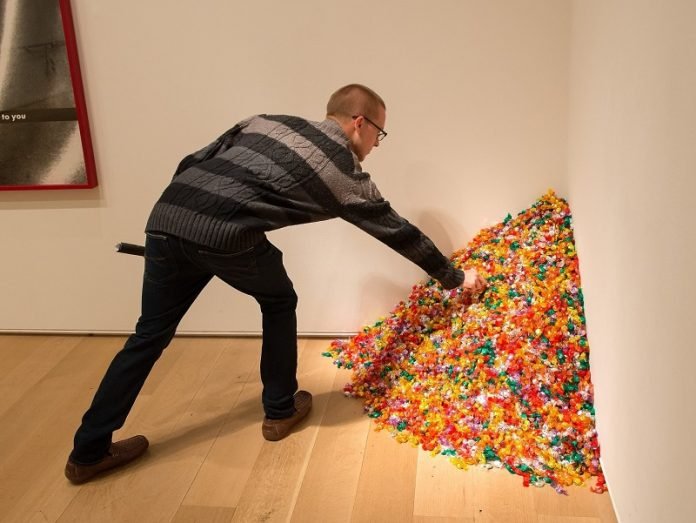
What exactly did the Crystal Bridges Museum get when it bought the artwork “Untitled” (L.A.), 1991 for $7.8 million?
“From a legal perspective, absolutely nothing,” a law professor says.
One day in 2016, law professor Guy Rub was visiting The Jewish Museum in New York City when he came across a work of conceptual art that made him pause.
But it wasn’t just the art itself that made an impression – it was the label that described the artwork.
The work, “Untitled” (USA Today), 1990, by the artist Felix Gonzalez-Torres, consisted of candies individually wrapped in red, silver and blue cellophane, arranged on the floor. Gallery visitors were encouraged to take the candies, which were then replenished by museum staff.
What struck Rub was the notation on the label that said the artwork was from “The Museum of Modern Art, New York, gift of the Dannheisser Foundation, 1996.”
“As someone who studies copyright and intellectual property law, that language fascinated me,” said Rub, who is a professor at the Moritz College of Law at The Ohio State University.
“In what sense was this art from MoMA? What did they own? The candies didn’t come from the Museum of Modern Art. The artist himself, who died in 1996, never touched the work that was displayed. It raised so many questions.”
The questions aren’t just academic.
In November 2015, the Crystal Bridges Museum of American Art in Bentonville, Arkansas, announced that it acquired a similar artwork by Gonzalez-Torres called “Untitled” (L.A.), 1991.
In this piece, “small, green candies wrapped in cellophane are spread across the gallery floor, so that viewers may touch, take, and consume the work, which can be endlessly replenished,” the museum announced on its website.
The Wall Street Journal reported that the museum paid $7.8 million for the piece. But what exactly did the museum get for that multimillion-dollar price?
Questions like that, and his own experience at The Jewish Museum, inspired Rub to interview 13 art industry insiders, including curators, collection managers, and senior administrators at museums and galleries, about the legal issues of ownership in the art world.
He reviewed legal documents, such as contracts, published interviews with industry insiders and studied industry publications and websites. He published his findings last year in the BYU Law Review.
In the article, Rub concluded that conceptual art challenges core notions and hidden assumptions in the law in ways that other forms of art don’t. If you buy a painting by Van Gogh, you know exactly what you’re getting. You’re getting a physical object that can be transferred from one owner to another. Only one true version of that painting exists.
But conceptual art – like the works of Gonzalez-Torres – are different. In these works, the idea behind the work is more important than the actual art object itself.
The problem, though, is that ideas can’t be legally protected by copyright. Ideas can’t be owned (with few exceptions). But museums still buy and sell works of conceptual art for millions of dollars and use terms like “copyright” in ways that the law doesn’t recognize, Rub said.
“Nobody can seriously claim that copyright law protects the notion of placing green candies on a gallery floor for viewers to take,” Rub said.
So what exactly did the Crystal Bridges Museum get when it bought “Untitled” (L.A.), 1991 for $7.8 million?
“From a legal perspective, absolutely nothing,” Rub said. “When the Crystal Bridges Museum bought this piece, they bought something that the law does not recognize. It is owning nothingness.”
No law prevents any museum or gallery from buying 175 pounds of individually wrapped candies in cellophane and presenting them as a work of art, he said. The work could be visually identical to the Felix Gonzalez-Torres installation that the Crystal Bridges Museum paid $7.8 million for. Rub asks: Why wouldn’t such a work be as authentic and identical in all respects to the work that the Crystal Bridges Museum “owns”?
The reason that no museums do this is because of the very powerful social norms of the industry, Rub said. The law may not back up their claims of ownership and copyright, but that hardly matters.
“The truly crucial aspect of this norm is that the people I interviewed stressed over and over that they would never present an installation of a work like that of Felix Gonzalez-Torres without receiving permission of the pseudo-owner,” Rub said.
“When I asked people why they wouldn’t consider doing this, most of them could barely understand the question. In one way or another, they all told me it would be presenting a forgery, which I found fascinating. How can it be a forgery when there is no original?”
Social norms are one thing. But why do museums and galleries use legal terms like “copyright” when they are in these cases, as Rub says, “legal nothingness?”
Rub said he tried to explore with museum and industry officials whether they knew there was a gap between copyright law and their use of copyright terminology and copyright notices. He said their answers were often unsatisfactory and vague.
Officials said things like they “didn’t think about this before” or that using copyright terminology was “something that the [artist] wanted us to do.”
In the end, the use of legal terminology may be less about the law than it appears.
“This inaccurate use of legal terms might be a way for the industry to give even greater legitimacy to its norms,” he said. “It gives them legal cover, even if it doesn’t mean what it says.”
The disconnect between law and the social norms of the art industry doesn’t end when a piece of conceptual art is sold, Rub said.
Normally, when an object is sold, the connection between the seller and buyer is over, at least legally.
“But conceptual artists routinely exercise post-sale control over their sold works. The artists often can control how their work is shown and even who is involved in creating the presentation,” he said.
“Owners of the work are often incredibly deferential to the artists they purchased it from.”
Rub said that while the current system of ownership of conceptual art doesn’t provide the legal protections to owners that they may think it does, it doesn’t matter.
The system works because the art industry needs it. It is a community of insiders that want creativity to be rewarded. The norms of the art industry ensure that artists like Felix Gonzalez-Torres can make a living, Rub said.
The norms are strong enough to protect all involved.
“It wouldn’t be the end of the world if some small gallery created an exhibition of Felix Gonzalez-Torres’ work that is not authorized. They would, however, be shunned by the rest of the art community and find it hard to continue to operate,” Rub said.
“But we need to explore ways for how the law might develop to account for richer understandings of ownership including what it means to own some kinds of art.”
Written by Jeff Grabmeier.



